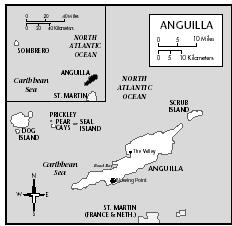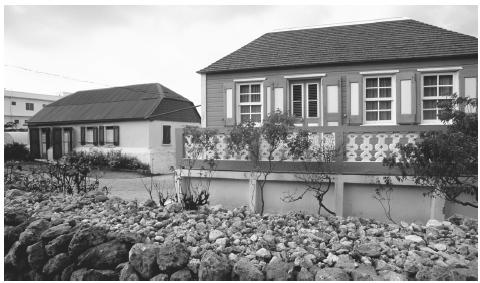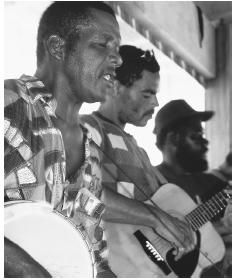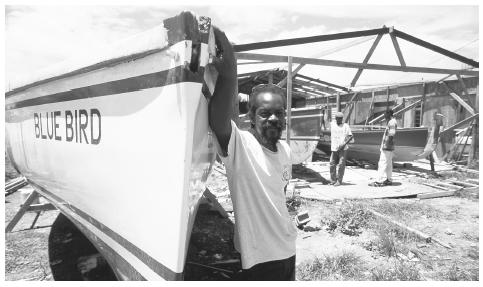Anguilla
Culture Name
Anguillan
Orientation
Identification. Anguilla, a dependent territory of the United Kingdom, is one of the Leeward Islands. According to tradition, Christopher Columbus gave the small, narrow island its name in 1493 because from the distance it resembled an eel, or in Italian, anguilla. It is also possible that French navigator Pierre Laudonnière gave the island its name from the French anguille.
Location and Geography. Anguilla is the most northern of the Leeward Islands in the Lesser Antilles in the eastern Caribbean Sea. Nearby islands include Scrub, Seal, Dog and Sombrero Islands and Prickly Pear Cays. Anguilla is five miles (eight kilometers) north of Saint Martin and sixty miles (ninety-seven kilometers) northeast of Saint Kitts. Anguilla's land area covers thirty-five square miles (ninety-one square kilometers). It is sixteen miles (twenty-six kilometers) long and three-and-one-half miles (six kilometers) wide, with a highest elevation of two-hundred -thirteen feet (sixty-five meters), at Crocus Hill. The largest town, in the center of the island, is The Valley. Relatively flat, Anguilla is a coral and limestone island with a very dry climate. It is covered with sparse vegetation, and there are few areas of fertile soil; most of the land is more adapted to grazing. Anguilla does not have any rivers, but there are several salt ponds, which are used for the commercial production of salt. The climate is sunny and dry year-round, with an average temperature of 80 degrees Fahrenheit (27 degrees Celsius). Anguilla is in an area known for hurricanes, which are most likely to strike from July to October.
Demography. Originally inhabited by some of the Carib peoples who came from northern South America, Anguilla was later colonized by the English, in the 1600s. Today the majority of the population is of African descent. The minority Caucasian population is mostly of British descent. The population on average is very young; more than one third are under the age of fifteen. Anguilla has a total permanent population of about nine thousand.
Linguistic Affiliation. The official language of Anguilla is English. A Creole language, derived from a mixture of English and African languages, also is spoken by some Anguillans.
Symbolism. The flag of Anguilla was changed several times in the twentieth century. The present flag consists of a dark blue field with the Union Jack, the flag of Great Britain, in the upper left corner, and Anguilla's crest to the center-right side. The crest consists of a background that is white on top and light blue below and has three gold dolphins jumping in a circle. For official government purposes outside Anguilla, the British flag is used to represent the island.
History and Ethnic Relations
Emergence of the Nation. Anguilla was first inhabited several thousand years ago and at various times by some of the Carib peoples who arrived from South America. One of these groups, the Arawaks, settled in Anguilla more or less permanently in about 2000 B.C.E. The first Europeans to arrive on the island were the English, who had first colonized Saint Kitts, and then Anguilla in 1650. By this time the Arawaks had vanished, probably wiped out by disease, pirates, and European explorers. However, in 1656 the English in turn were massacred by a group of Caribs, famous for their skill as warriors and farmers. The English eventually returned and attempted to cultivate the land but Anguilla's dry climate prevented its farms from ever becoming profitable.
For the next 150 years, until about 1800, Anguilla, like other Caribbean islands, was caught in

During the 1600s most Anguillans survived by working small plots of land, fishing, and cutting wood for export. Indentured European servants provided most of the labor. However, by the early 1700s, the slave-plantation system was gradually beginning to become the dominant economic system in the eastern Caribbean. The growth of the slave trade was directly tied to the cultivation of sugarcane, which was introduced to the West Indies in the late 1600s from the Mediterranean. It quickly became the most valuable cash crop. Harvesting and processing sugarcane was labor-intensive and required a large workforce. Plantation owners soon discovered that it was more profitable to use slaves, forcibly brought from Africa, rather than indentured servants, to work the sugar plantations. Although Anguilla was never a major sugar producer, its proximity to other West Indian islands caused it to be greatly influenced by the plantation system and the slave trade. As the slave system continued to grow throughout the 1700s, Anguilla's population of people of African descent grew.
In 1824 the government of Great Britain created a new administrative plan for their territories in the Caribbean, which placed Anguilla under the administrative authority of Saint Kitts. After more than a century of independence, Anguillans resented this change and believed that the government of Saint Kitts had little interest in their affairs or in helping them. The conflict between Saint Kitts and Anguilla would not be resolved until the twentieth century. A significant change in Anguilla's social and economic structure occurred when England's Emancipation Act of 1833 officially abolished the slave trade in its Caribbean colonies. By 1838, most of the landowners had returned to Europe; many of them sold their land to former slaves. Anguilla survived for the next century on a subsistence agricultural system, with very little change from the mid-1800s until the 1960s.
Anguillans made frequent requests for direct rule from Great Britain throughout the late nineteenth and early twentieth centuries but continued to remain under the authority of Saint Kitts. In 1967 Anguillans rebelled, disarming and capturing all of Saint Kitts's government officials stationed in Anguilla. Anguillans later even invaded Saint Kitts, and finally, in 1969, the British government intervened, sending in four hundred troops. The British military were openly welcomed by Anguillans and in July 1971 the Anguilla Act was passed, officially placing the island under direct British control. It was not until 19 December 1980 that the island was formally separated from Saint Kitts.
Anguilla's position as first a colony, and then a dependent of another British territory, has prevented it from developing as an independent nation like other larger, Caribbean islands. Since 1980 Anguilla has prospered as a separate dependent territory. With an overall increase in economic prosperity and the end of conflict with Saint Kitts, Anguillans are today optimistic about their future.
National Identity. Anguillans are proud of their independence and unique identity as one of the smallest inhabited Caribbean islands. They identify culturally with both Great Britain and the West Indies. Industrious and resourceful, Anguillans are known for working together to help each other through hurricanes, drought, and other problems. Great differences in wealth do not exist; consequently there is a general sense of unity among Anguillans of all backgrounds.
Ethnic Relations. Problems of ethnic, racial, and social class conflict have always been minimal in Anguilla. The island's small size and lack of fertile

Urbanism, Architecture, and the Use of Space
Housing conditions are generally good, and urban development greatly improved when badly needed public buildings, roads, and water systems were built in the 1960s. Compared to many other islands, urban planning is generally good. Apart from exclusive resort hotels that cater to a foreign tourist trade, Anguillan buildings are typically simple but rather large concrete constructions. Most construction materials must be shipped in, and the frequent occurrence of hurricanes necessitates particular construction methods. Anguilla's sunny and mild climate easily permits outdoor living year-round. Anguillan buildings often have balconies or terraces and take advantage of Anguilla's brilliant sunlight. Slightly more than half of Anguilla's roads are paved. There are two small ports and one airport.
Food and Economy
Food in Daily Life. With an abundant supply of seafood, fruit, and vegetables, food in daily life is fresh and reflects Anguilla's cultural history. Lobster is common and an important export as well. As the Caribbean has become an increasingly popular tourist destination, the demand for lobster continues to grow. Lobster and crayfish are often prepared with cilantro and plantains. Red snapper, conch, and whelk are also typical to Anguilla. Other dishes include mutton stew with island vegetables, and pumpkin soup. Anguilla also manufactures its own brand of soda, using local ingredients. Salted fish, curried goat, and jerk chicken also are popular.
Basic Economy. Tourism is now the mainstay of Anguilla's economy, but other important economic activities include fishing, especially lobster and conch; salt production; raising of livestock; and boat building. There is a small financial services industry that the British and Anguillan governments are trying to expand. Money sent back to the island from Anguillans who have moved abroad also is important to the overall economy. There is no income tax; customs duties, real estate taxes, bank licenses, and the sale of stamps provide revenue for the Anguillan government. Both the eastern Caribbean dollar and the U.S. dollar are used as currency.
Land Tenure and Property. Anguilla's dry climate had always discouraged potential settlers in the past, but with the rise of tourism, land and property values have soared. Strict control of land and inaccessibility to it have helped keep real estate development from growing uncontrollably. Clean beaches and plant and animal life abound. With the end of slavery in the 1830s, land was divided into small plots among the island's residents. A few tourist hotels have been built in recent years, but not the large private resorts found in other parts of the Caribbean.
Commercial Activities. Tourism and related activities are now the most widespread commercial concerns. Hotels, restaurants, bars, excursion boating and diving, tourist shops, and transportation services are the most widespread commercial activities. The food business, such as markets and bakeries, also is significant. Anguilla produces and sells collectible stamps and this is a small but lucrative part of the economy.
Major Industries. Anguilla is not industrialized. Fishing, particularly lobster, constitutes major exports to other parts of the Caribbean and to the United States. Salt, produced by natural evaporation from salt ponds on the island, occurs in quantities large enough for export. Agricultural production, for Anguillan consumption as well as for other islands, includes corn, pigeon peas, and sweet potatoes. Meat products are from sheep, goats, pigs, and chickens.
Trade. Great Britain and its neighboring islands are Anguilla's most frequent and important trading partners. Seafood and salt are still important exports. A large number of consumer goods and materials must be imported. With a stronger economy, Anguillans are able to afford many items that would have been prohibitively expensive twenty years ago.
Division of Labor. Anguilla has a low standard of living, and employment is often unsteady. Many younger Anguillans go abroad to find work, either to Great Britain, the United States, or to other, larger Caribbean islands. Since Anguilla's independence from Saint Kitts and the growth of the tourist sector, unemployment rates have dropped dramatically. There is now a shortage of labor, which has led to delays in some of the government-sponsored economic plans as well as price and wage increases. More work visas are being granted to non-Anguillans, but with the demand for labor high, many Anguillans hold more than one job. The British government provides support for a development and jobs program, and the Caribbean Development Bank also has contributed funds to help provide work and stimulate growth.
Social Stratification
Classes and Castes. There is very minimal class distinction among native Anguillans. The small Caucasian minority is not an elite, power-holding group; likewise, the African-descent majority does not discriminate or economically isolate the ethnic minority.
Political Life
Government. As Anguilla is a dependent territory of Great Britain, Anguilla's government is under the authority of the British government at Westminster, London. Anguilla's government consists of the governor, the Executive Council, and the House of Assembly. The governor, who holds executive power, is appointed by the British monarch. The governor is responsible for external affairs, internal financial affairs, defense, and internal security. The Executive Council advises the governor. The House of Assembly has two ex officio members, two nominated members, and seven elected members. Other political positions include that of attorney general and secretary to the Executive Council.
Leadership and Political Officials. Before Anguilla became a dependent British territory, the chief minister held executive power. For two decades the position of chief minister alternated between two political rivals: Ronald Webster of the People's Progressive Party, and Emile Gumbs of the Anguilla National Alliance. Several coalition governments were formed during this period as Anguillans sought to obtain total independence from Saint Kitts. The chief executive is now the governor. In 1990 the position of deputy governor was created. The three ruling parties are the Anguilla United Party, the Anguilla Democratic Party, and the Anguilla National Alliance.
Social Problems and Control. Until recently, Anguilla's most urgent social problem was unemployment. The rapid expansion of the economy and the sudden demand for labor have caused unemployment rates to drop dramatically. However, Anguillans

Military Activity. Great Britain is responsible for Anguilla's defense. The island has a small police force.
Social Welfare and Change Programs
As a dependent territory, Great Britain provides economic aid and social programs for Anguilla. Other development and welfare programs are supported by the United Nations and the United States. These programs are for general Caribbean economic development, increasing trade and improving living conditions. They also provide assistance in times of natural disaster.
Gender Roles and Statuses
Division of Labor by Gender. More Anguillan women work outside the home than a generation ago, but men still comprise the majority of the workforce. Women own shops or work in the tourist business, in hotels, restaurants, or markets. Women are also employed in agricultural work. However, many women may stop working temporarily when they have young children, returning to work when their children are more independent. Since many businesses and farms are small and family-run, women have a degree of autonomy in work. The recent high demand for labor has also provided jobs for women that previously were nonexistent. Men are more likely than women to be involved in businesses such as fishing, boat construction, and running diving and sailing businesses for tourists.
The Relative Status of Women and Men. General economic and living conditions have improved for all Anguillans. However, more men than women travel abroad to find work, hold political office, and own businesses. The home and family are still considered to be women's main responsibilities, and for the most part women are dependent on male family members or husbands for economic support.
Marriage, Family, and Kinship
Marriage. The extended family is central to Anguillan and West Indian societies in general. Despite the strong influences of the Methodist and Anglican Churches, historically marriage was not considered obligatory for the creation of a family or a domestic living arrangement. During the eighteenth and nineteenth centuries, apart from the small upper class of English landowners, social conditions and slavery made the creation of long-lasting unions very difficult. Men and women frequently lived together in common law marriages for varying lengths of time. It was not infrequent for women and men to have children with more than one partner. Marriage in the Western sense was more likely to occur among the upper and middle classes. Today marriage is considered a cornerstone of family and social life, and weddings are community events.
Domestic Unit. The basic domestic unit is generally a family headed by a mother and father. Under them are their children, often with one or more older relative, such as a grandparent, living under the same roof. As a result of very minimal class and economic differences, Anguillan family life has generally been more stable from a historical point of

Inheritance. Today as a British dependent territory, Anguilla's laws governing inheritance are based on Great Britain's. Until recently, inheritance always passed to the oldest son, or to oldest daughter if there were no males heirs. Past inheritance laws also excluded women from holding property.
Kin Groups. The extended family, particularly the network of female family members, often extends to include whole communities in Anguilla. The island's population is descended from the small group of people who arrived there two centuries ago, and as a result family groups are the basis for Anguillan society. Kin groups are extensive yet closely-knit, united by their collective past. A kin group can include many related families living near each other, or families in various parts of the island bound by surname. In terms of domestic organization and management, kin groups are matriarchal in nature, with mother and grandmothers taking responsibility for important family decisions.
Socialization
Infant Care. Infants and young children are cared for at home by their mothers or other female relatives. Increased government spending for education has provided funds for early childhood education and care and assistance to working mothers. However, most children remain at home until they begin elementary school at age five.
Child Rearing and Education. Anguilla, like many other islands of the West Indies, sought to improve literacy rates and educational standards in the second half of the twentieth century. Between the ages of five and fourteen education is obligatory and free through a public school system. There are several primary schools and a secondary school.
Higher Education. For advanced, specialized training or a university degree, Anguillans must either go to another Caribbean country or leave the area. In 1948 the University of the West Indies was established in Jamaica to provide higher education for all English-speaking countries in the region. It has created an intellectual center for the West Indies in general and serves as an important contact with the international academic community.
Etiquette
Although the daily pace is generally relaxed and unhurried, Anguillans maintain a degree of formality in public life. Politeness and manners are considered important. As Anguilla's popularity as a tourist destination has grown, Anguillans have found themselves faced with confronting the problems that tourism can bring while trying not to lose an important source of income. Nude sunbathing is strictly prohibited, and wearing swimsuits anywhere outside of beach areas is not permitted. Anguillans always address each other by title—Mr., Mrs., etc.—unless they are on very personal terms. People in positions of importance are addressed using their job title with their last names, such as Nurse Smith or Officer Green. In an effort to maintain its low crime rate, Anguilla also enforces a strict antidrug policy, which includes careful search of all items or luggage brought onto the island.
Religion
Religious Beliefs. Protestant churches, namely Anglican and Methodist, constitute the largest religious affiliation. Roman Catholicism is the second-largest religious group. Obeah, which is similar to voodoo and based on religious practices of African slaves brought to Anguilla, also is practiced by some.
Medicine and Health Care
Health standards are good, and birth and death rates are balanced. Anguilla has a small hospital, and limited health care is available through a government health program. For complicated or long-term medical treatment Anguillans must leave the island.
Secular Celebrations
Important secular holidays and celebrations include Anguilla Day, 30 May; the Queen's Birthday, 19 June; Caricom Day, 3 July; Constitution Day, 11 August; and Separation Day, 19 December. Carnival is held the first week of August and includes parades, folk music, traditional dances, competitions, and a street fair. Colorful and elaborate costumes are worn in the Carnival parades, and it is a time for Anguillans to celebrate their history.
The Arts and Humanities
Anguilla has several small art galleries, shops that sell local crafts, and a museum with exhibitions relating to Anguillan history, including prehistoric artifacts found on the island. Although there is no permanent theater on the island, various theatrical performances are held regularly. The Anguilla Arts Festival is held every other year and includes workshops, exhibits, and an art competition.
Bibliography
Burton, Richard D.E. Afro–Creole: Power, Opposition, and Play in the Caribbean, 1997.
Comitas, Lambros, and David Lowenthal. Work and Family Life: West Indian Perspectives, 1973.
Kurlansky, Mark. A Continent of Island: Searching for Caribbean Destiny, 1993.
Lewis, Gordon K. The Growth of the Modern West Indies, 1968.
Rogozinski, Jan. A Brief History of the Caribbean: From the Arawak and Carib to the Present, 2000.
Westlake, Donald. Under an English Heaven, 1973.
Williams, Eric. From Columbus to Castro: A History of the Caribbean, 1492–1969, 1984.
Web Sites
"Calabash Skyviews." Anguilla history homepage. www.skyviews.com .
—M. C AMERON A RNOLD
Does it ever rain.Does it ever snow?What do the people look like.
What kind of sports do they do?
Peace and Joy to all. Joseph
Peace Love and Joy Claudia